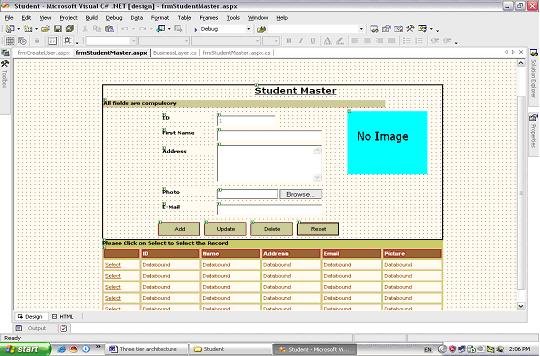|
Products
Database Search Solution (New Version) Search Control SEO Pager Highlighter Shortcut Controls Crypt Package Free ASP.NET Controls
Geotargeting Component ASP.NET Media Player Control Flash Video Player Control Services
ASP.NET Telecommute Jobs Free IP Location Lookup Test .Net Regular Expressions CSS/Table/DIV Page Layouts Custom Programming Article Sites Master List |
Three Tier Architecture in ASP.NET3-tier application is a program which is organized into three major disjunctive tiers on layers. Here we can see that how these layers increase the reusability of codes. These layers are described below. 1. Application layer or Business layer Advantages of three Tier Architecture.The main characteristic of a Host Architecture is that the application and databases reside on the same host computer and the user interacts with the host using an unfriendly and dump terminal. This architecture does not support distributed computing (the host applications are not able to connect a database of a strategically allied partner). Some managers found that developing a host application take too long and it is expensive. Consequently led these disadvantages to Client-Server architecture. Client-Server architecture is 2-Tier architecture because the client does not distinguish between Presentation layer and business layer. The increasing demands on GUI controls caused difficulty to manage the mixture of source code from GUI and Business Logic (Spaghetti Code). Further, Client Server Architecture does not support enough the Change Management. Let suppose that the government increases the Entertainment tax rate from 4% to 8 %, then in the Client-Server case, we have to send an update to each clients and they must update synchronously on a specific time otherwise we may store invalid or wrong information. The Client-Server Architecture is also a burden to network traffic and resources. Let us assume that about five hundred clients are working on a data server then we will have five hundred ODBC connections and several ruffian record sets, which must be transported from the server to the clients (because the Business layer is stayed in the client side). The fact that Client-Server does not have any caching facilities like in ASP.NET, caused additional traffic in the network. Normally, a server has a better hardware than client therefore it is able compute algorithms faster than a client, so this fact is also an additional pro argument for the 3.Tier Architecture. This categorization of the application makes the function more reusable easily and it becomes too easy to find the functions which have been written previously. If programmer wants to make further update in the application then he easily can understand the previous written code and can update easily. Application layer or Presentation layerApplication layer is the form which provides the user interface to either programmer of end user. Programmer uses this layer for designing purpose and to get or set the data back and forth.  Business layerThis layer is a class which we use to write the function which works as a mediator to transfer the data from Application or presentation layer data layer. In the three tier architecture we never let the data access layer to interact with the presentation layer. a. Property LayerThis layer is also a class where we declare the variable corresponding to the fields of the database which can be required for the application and make the properties so that we can get or set the data using these properties into the variables. These properties are public so that we can access its values. Data Access LayerThis layer is also a class which we use to get or set the data to the database back and forth. This layer only interacts with the database. We write the database queries or use stored procedures to access the data from the database or to perform any operation to the database. Summary
Data flow from application layer to data layerYou can download sample three tier project, used for this tutorial. Here we are passing the code of the student to the business layer and on the behalf of that getting the data from the database which is being displayed on the application layer. Presentation Layer:
private
void DataGrid1_SelectedIndexChanged(object
sender, System.EventArgs e) Property Layer
// These are the properties has been defined in the property layer. Using the
object of the property layer we can set or get the data to or from these
properties. Business Layer: "Obj" is the object of the clsStudent class has been defined in the property layer. This function is receiving the property object and passing it to the datalayer class
// this is the function of the business layer which accepts the data from the
application layer and passes it to the data layer. Datalayer Layer
// this is the datalayer function which is receiving the data from the business
layer and This is the implementation of the single function for more please see the sample application attached with the note. Tutorial toolbar: Tell A Friend | Add to favorites | Feedback | |

